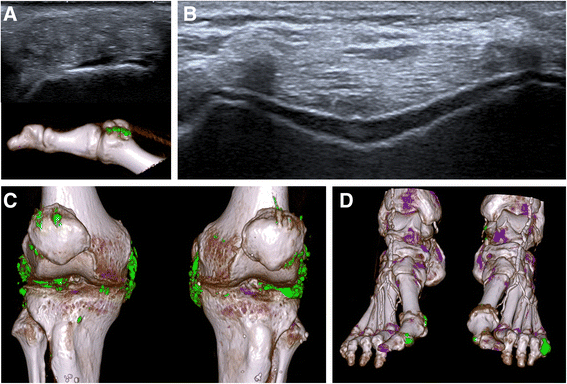Ultrasonography and dual-energy computed tomography provide different quantification of urate burden in gout: results from a cross-sectional study
- PMID: 28732526
- PMCID: PMC5521183
- DOI: 10.1186/s13075-017-1381-2
Ultrasonography and dual-energy computed tomography provide different quantification of urate burden in gout: results from a cross-sectional study
Abstract
Background: Ultrasonography (US) and dual-energy computed tomography (DECT) can assess urate burden in gout. The objective of this study was to compare the quantification of urate deposition provided by US to the one provided by DECT.
Methods: Patients with a diagnosis of gout were prospectively recruited to undergo quantification of urate deposition using US and DECT. US examination for tophi and the double contour (DC) sign was performed on the knees and feet and corresponding DECT scans provided volumes of tophi and of overall urate deposition. The primary endpoint was the intra-class correlation coefficient (ICC) of the volume of the index tophus measured by US and DECT and its 95% confidence interval (CI 95%).
Results: Of the 64 patients included, 34 presented with at least one tophus on US. DECT inter-reader agreement for urate deposition was perfect with an ICC of 1 (1-1) and good for the measurement of the index tophus with an ICC of 0.69 (0.47-0.83). The ICC for the measurement of the index tophus between the two techniques was poor with a value of 0.45 (0.1-0.71). The average ratio between the index tophi volume as assessed by DECT and US was 0.65. The number of DC-positive joints did not correlate with DECT volume of overall deposits (Spearman correlation coefficient of 0.23).
Conclusions: DECT measurements of tophi give smaller volumes to the same tophi measured with US, and US signs of urate deposition in joints do not correlate with overall DECT volumes of extra-articular deposition.
Keywords: Double contour; Dual-energy computed tomography; Gout; Tophus; Ultrasonography.
Conflict of interest statement
Ethics approval and consent to participate
Ethical approval for the study was received from the Institutional Medical Ethics Review Board of the Lille Catholic Hospitals (reference number 2016-04-06). All patients provided informed consent.
Consent for publication
Not applicable.
Competing interests
The authors declare that they have no competing interests.
Publisher’s Note
Springer Nature remains neutral with regard to jurisdictional claims in published maps and institutional affiliations.
Figures


Similar articles
-
The lack of association between the burden of monosodium urate crystals assessed with dual-energy computed tomography or ultrasonography with cardiovascular risk in the commonly high-risk gout patient.Arthritis Res Ther. 2018 May 29;20(1):97. doi: 10.1186/s13075-018-1602-3. Arthritis Res Ther. 2018. PMID: 29843788 Free PMC article.
-
Assessment of tophus size: a comparison between physical measurement methods and dual-energy computed tomography scanning.J Clin Rheumatol. 2012 Jan;18(1):23-7. doi: 10.1097/RHU.0b013e31823e5cda. J Clin Rheumatol. 2012. PMID: 22157268
-
Comparison of dual-energy CT, ultrasound and surface measurement for assessing tophus dissolution during rapid urate debulking.Clin Rheumatol. 2017 Sep;36(9):2101-2107. doi: 10.1007/s10067-017-3729-z. Epub 2017 Jun 16. Clin Rheumatol. 2017. PMID: 28623421
-
Dual-energy computed tomography for gout diagnosis and management.Curr Rheumatol Rep. 2013 Jan;15(1):301. doi: 10.1007/s11926-012-0301-3. Curr Rheumatol Rep. 2013. PMID: 23292817 Review.
-
What Has Dual Energy CT Taught Us About Gout?Curr Rheumatol Rep. 2021 Jul 14;23(9):71. doi: 10.1007/s11926-021-01035-5. Curr Rheumatol Rep. 2021. PMID: 34259946 Review.
Cited by
-
Utility of Ultrasound and Dual Energy CT in Crystal Disease Diagnosis and Management.Curr Rheumatol Rep. 2020 Apr 15;22(5):15. doi: 10.1007/s11926-020-0890-1. Curr Rheumatol Rep. 2020. PMID: 32291581 Review.
-
Assessment of cardiovascular risk profile based on measurement of tophus volume in patients with gout.Clin Rheumatol. 2018 May;37(5):1351-1358. doi: 10.1007/s10067-017-3963-4. Epub 2017 Dec 29. Clin Rheumatol. 2018. PMID: 29288369
-
Current status of ultrasound and dual-energy computed tomography in the evaluation of gout.Rheumatol Int. 2018 Aug;38(8):1339-1344. doi: 10.1007/s00296-018-4033-1. Epub 2018 May 2. Rheumatol Int. 2018. PMID: 29721694 Review.
-
Optimization of dual energy computed tomography post-processing to reduce lower limb artifacts in gout.Quant Imaging Med Surg. 2022 Jan;12(1):539-549. doi: 10.21037/qims-21-321. Quant Imaging Med Surg. 2022. PMID: 34993099 Free PMC article.
-
Concurrent validity of provisional remission criteria for gout: a dual-energy CT study.Arthritis Res Ther. 2019 Jun 21;21(1):150. doi: 10.1186/s13075-019-1941-8. Arthritis Res Ther. 2019. PMID: 31227018 Free PMC article.
References
-
- Shiozawa A, Szabo SM, Bolzani A, Cheung A, Choi HK. Serum uric acid and the risk of incident and recurrent gout: a systematic review. J Rheumatol. 2017 - PubMed
Publication types
MeSH terms
Substances
LinkOut - more resources
Full Text Sources
Other Literature Sources
Medical

